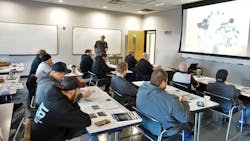The technician shortage has been continually touted as a national concern with a local solution. But what does getting involved truly look like?
In September, I listened in on the American Trucking Association’s (ATA) Technology & Maintenance Council’s (TMC) Technical Session, “Supporting Technical Education to Help Resolve Your Technician Shortage," held during the TMC virtual Fall Meeting. Panelists during the session shared real-world feedback on how fleet businesses and educators have worked together to establish effective communication and improve training curriculums.
A key driver to begin this process requires setting up formal, consistent meetings with key stakeholders to help ensure proper training and update the training curriculum as needed. Accredited education institutions often have an established program advisory committee (PAC) to gather input from community businesses. Fleets can represent these businesses by participating.
Who should be involved?
The list of individuals to consider on this committee includes representatives from the educational facility, fleet businesses hiring students after graduating, and any community members with a vested interest in local jobs.
As it relates specifically to fleets, George Arrants, Vice President of ASE Education Foundation, suggests the maintenance director, service manager, and even technicians – especially those that may have gone through the educator’s training program – can all benefit from attending these meetings.
From the educator’s perspective, decision-makers on campus such as academic deans, program directors, and faculty members should participate, suggests Brad Kuykendall, CEO of Western Technical College.
“Best practice is to also bring in a couple of current students as well, so they can hear exactly what industry is looking for and how the school is reacting and modifying to meet industry needs,” Kuykendall says.
A chairperson can help facilitate and drive the conversation during these regular meetings.
“Normally, a program advisory committee chair or PAC chair is an industry leader that's out day-to-day in operations – either in fleet management, dealership management,” Kuykendall says. “They're the ones who are leading and guiding the discussions and the feedback on how the program can improve, whether it be in terms of curriculum, equipment, the tools that are issued out to the students in order to prepare them for their work environment.”
Arrants suggests finding an industry leader to serve as the PAC chair – a business owner or executive manager, at least for the initial meeting – to show that the community is committed to helping drive changes to the training programs.
“Find somebody who has stature and importance in the community to start,” Arrants suggests. “But anybody in your organization can serve, and multiple people from the same organization can serve on that PAC.”
Local and state legislators may also provide additional insight and welcome the opportunity to help promote skilled trades. These individuals have a vested interest in the community as well.
“The fact of the matter is that in most states, the shortage of skilled labor has become enough of an issue that legislators are scrambling to come up with creative and effective solutions,” says Kenneth Calhoun, fleet optimization manager for Altec Fleet Services.
Technicians that have gone through the program are also key in driving change with direct feedback from the experience.
“Probably the most important person to serve on that PAC meeting is former students; they’re the true checks and balances,” Arrants notes. “They learned in the program, and more importantly, how they've been able to apply it to the workforce. And if there were any hiccups or disconnects along the way, getting feedback from former students really helps grow the program because they're the true customers.”
Agenda and goals
"All of the agenda items should be related around budget, student surveys, graduate surveys, facility evaluations, internships, workplace learning, all the things that engage students and ensure that the students and the program have the resources it needs,” Arrants says. “So once again, before you schedule a meeting, or create a meeting, determine what you expect to get out of that meeting, and create the agenda backwards.”
When conducting and participating in these meetings, school representatives should take detailed notes and share meeting minutes at the beginning of each gathering to review progress completed since the last meeting, Kuykendall says.
“It gives the PAC members an opportunity to review what they talked about the last time and gives the school an opportunity to report back on how they acted on those recommendations,” Kuykendall adds. “That's critical, because that ensures your input is valued, being taken into consideration, and being used for improvement to the programs.”
Transparency at these meetings is also critical, notes Arrants. Meeting minutes should be shared with key stakeholders at the school and in the community.
There should also be an openness from the educational facility to receive feedback. Kuykendall advises an educational facility truly has two customers: the students, and the future employers – in this case, fleets and dealerships. If the educational facility is not open to collaborating and making changes accordingly, consider working with other educational institutions that may welcome your fleet’s input.
“You absolutely cannot leave this for education to figure out on their own,” Calhoun says, regarding setting the training curriculum. “There's nobody in their ranks that has had to go through what we've gone through with the emissions regulations, or even has a solid grasp on the rate of change in our industry from advancements in technology or federal mandates. You have to be the voice that drives that change.”
About the Author
Erica Schueller
Editorial Director | Commercial Vehicle Group
Erica Schueller is a former editorial director of the Endeavor Commercial Vehicle Group.

